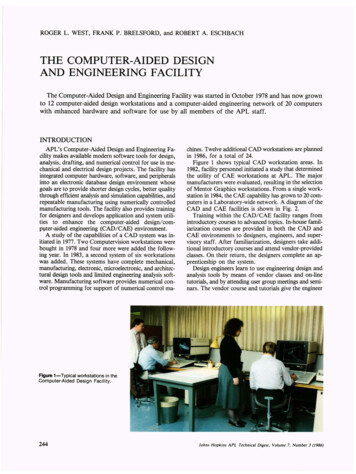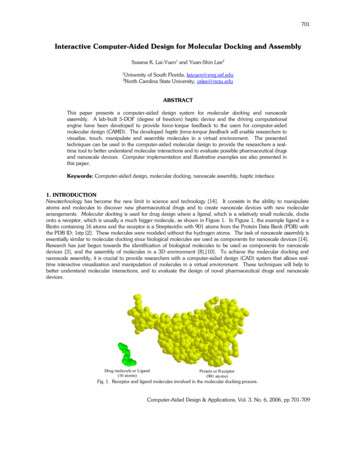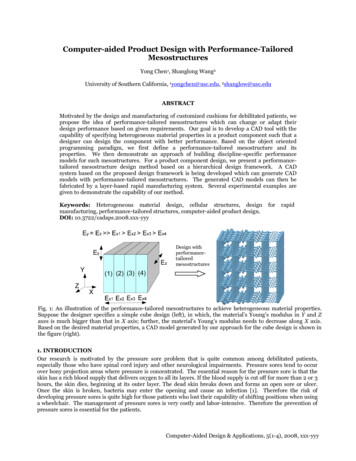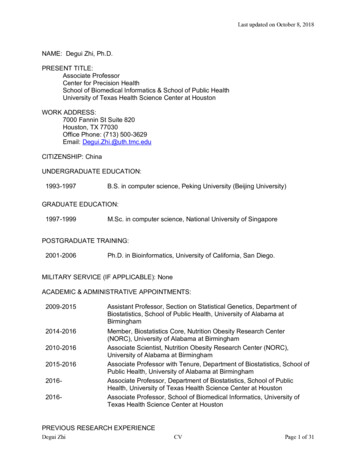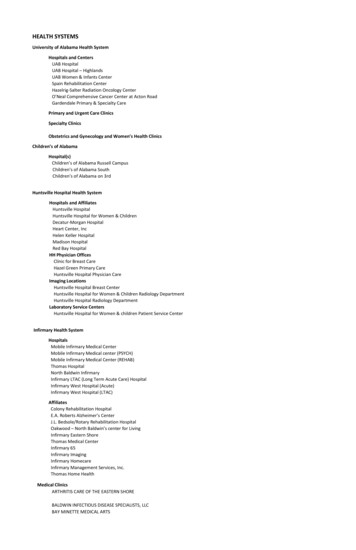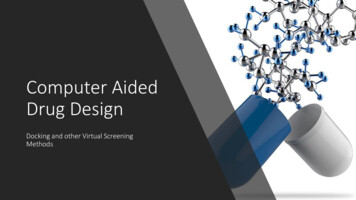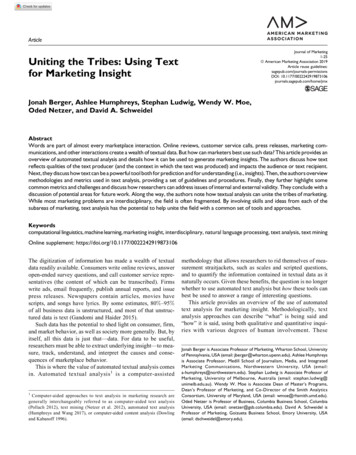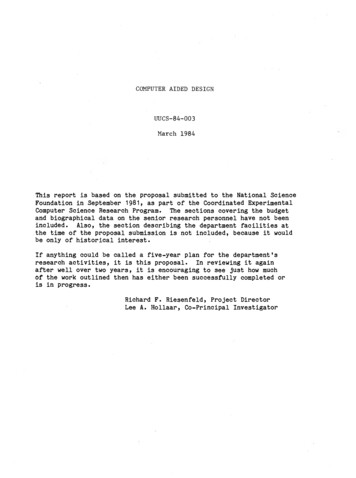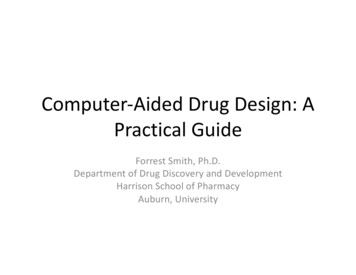
Transcription
Computer-Aided Drug Design: APractical GuideForrest Smith, Ph.D.Department of Drug Discovery and DevelopmentHarrison School of PharmacyAuburn, University
History of Drug Design Natural Products-Ebers Papyrus, 1500 B.C.documents over 700 plant based products usedto treat a variety of illnesses The rise of Organic Chemistry, middle or the 20thCentury, semi-synthetic and synthetic drugs Computers emerge in the late 1980s, CADD withminimal impact Automation in the 1990s, High Through-putScreening and Robotics, Compound Libraries CADD has continued to advance since itsintroduction with improving capabilities
Computational Chemistry Ab initio calculations Semi-empirical calculations Molecular Mechanics
Molecular Mechanics
Global Minimum
Force Fields MM2, MM3, MM4MMFFAMBERCHARMOPLS
Finding the Global Minimum Systematic SearchMonte Carlo MethodsSimulated AnnealingQuenched Dynamics
Minor Groove Binders
Computer-Aided Drug Design Structure Based Design– Docking– Molecular Dynamics– Free Energy Perturbation Ligand Based Design-QSAR– COMFA– Pharmacophore Modeling– Shape Based Methods
Docking-The Receptor X-Ray Crystal Structures– RCSB Protein Data Bank (https://www.rcsb.org/)– Private Data Homology Modeling Nuclear Magnetic Resonance
Docking- The Ligand Proprietary Ligands DatabasesqReal Databases FDA approved ml) Purchasable compoundsZinc 15, currently 100 million compounds(http://zinc15.docking.org/)q Virtual Databases- Enamines Real Database collections/real-database
Docking-Preparation Prepare the receptor–––––––Add hydrogensRemove water?Check ionizationAdd missing sidechains and atomsDeal with metals/subunitsMinimizeCreate the grid Prepare the ligands– Check ionization, tautomers, atom types
Docking-The Process Typical time to dock 1-100 sec/cmpd/cpu– Size of the active site– Size of the ligand– Number of rotatable bonds Typically only bonds in the ligand are allowedto rotate Induced fit docking increases docking time to20 min/cmpd/cpu
Docking-The Results A series of poses for each compound– Typically programs can redock ligands the protein wascrystallized with very well (RMSD 0-2 ngstroms) A docking score– Docking scores do not generally correlate well withexperimental binding data A ranking of the docked poses– Since the scores do not correlate with binding data,the ranking does not either
Docking-The ResultsOverlay of HDAC inhibitorPDB ID 4LY1Green experimentalGray predicted by GlideRMSD 0.44 Angstroms
Docking-The ResultsLigand Interaction DiagramexperimentalLigand Interaction Diagrampredicted
Experimental vs PredictedCB2 Agonists binding (bestresult) R2 0.49CB1 Agonists binding (typicalresult) R2 0.01
Enrichment What docking studies Docking of known CB2are best suited for isagonists(15 cmpds) compound enrichmentDUDE database (750cmpds) with CB2 Known actives arereceptordocked against eitherknown inactives ordecoys DUDE-Database ofuseful decoys:http://dude.docking.org
Modeling Programs Academic– Autodock Vina: http://vina.scripps.edu– Autodock: http://autodock.scripps.edu– Dock: http://dock.compbio.ucsf.edu/ Commercial– Schrodinger: https://www.schrodinger.com– MOE: https://www.chemcomp.com
Docking Servers Dock Blaster: http://blaster.docking.org Swissdock: http://www.swissdock.ch Z Dock Server: http://zdock.umassmed.edu
Homology Modeling Homology modeling allows for the creation ofstructural models when a protein has notbeen crystallized but the primary sequence isknown. Sequence homology should be greater than30% G-Protein Coupled Receptors can be especiallydifficult and exist in both agonist andantagonist forms
Homology ModelingHomology Servers SER/ Swiss-Model:https://swissmodel.expasy.org/Manual Homology edit Modeller:https://salilab.org/modeller/download installation.html
Free Energy Perturbation Addresses many of the problems associatedwith static docking– Uses molecular dynamics so the protein is allowedto move– May simulate the receptor existing in the cellmembrane, e.g. GPCRs– Incorporates the solvent in the calculation– Works best for solved crystal structures andcongeneric series of ligands.
FEP TheoryFrom Schrodinger, Inc. Calculates the relative freeenergy of converting ligand1 to ligand 2 in the solventand then calculates therelative free energy ofconverting 1 to 2 bound tothe receptor.
FEP Results Errors typically in the 1-3 kcal/mole Run on GPUs but a single run may take 24hours
Molecular Dynamics and FEP Programs ownload desmond.cgi NAMD: https://www.ks.uiuc.edu
Acknowledgements Graduate Students– Ms. Logan Neel– Mr. Mansour Alturki Supportq Department of Justice grant, GC-MS Studies on theSix Naphthoyl-Substituted 1-n-Pentyl-Indoles: JWH018 and Five Regioisomeric EquivalentsqAFPE fellowship 2019, Ms. Logan NeelqCNSi grant 2018, Auburn University, Ms. Logan Neel
Computer-Aided Drug Design: A Practical Guide Forrest Smith, Ph.D. Department of Drug Discovery and Development Harrison School of Pharmacy Auburn, University. History of Drug Design Natural Products-EbersPapyrus, 1500 B.C. documents over 700
